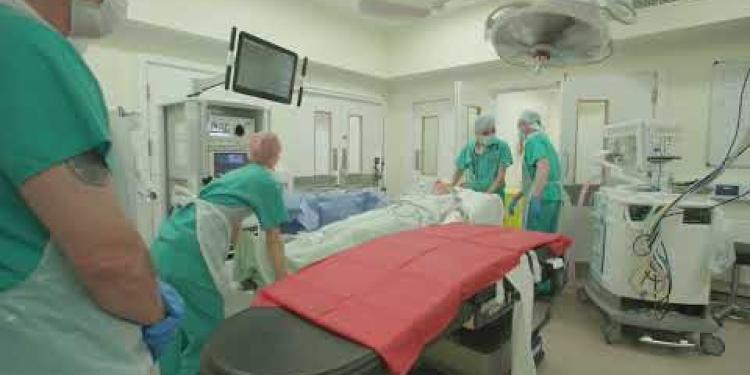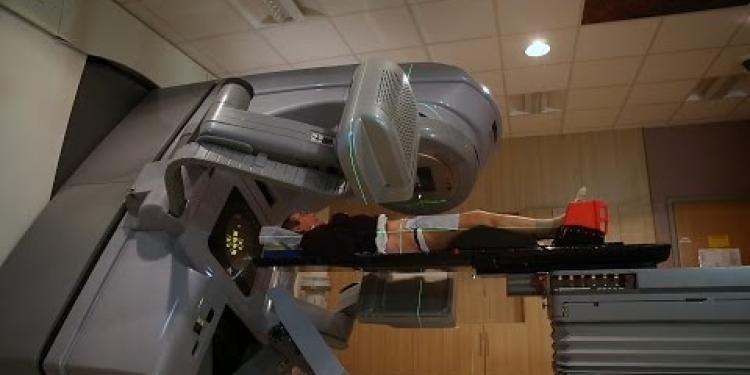Important Information On Using This Service
- Ergsy carefully checks the information in the videos we provide here.
- Videos shown by YouTube after a video has completed have NOT been reviewed by ERGSY.
- To view, click the arrow in the center of the video.
Using Subtitles and Closed Captions
- Most of the videos you find here will have subtitles and/or closed captions available.
- You may need to turn these on and choose your preferred language.
Turn Captions On or Off
- Go to the video you'd like to watch.
- If closed captions (CC) are available, settings will be visible on the bottom right of the video player.
- To turn on captions, click settings.
- To turn off captions, click settings again.
Find A Professional
Diagnosing prosate cancer
Diagnosing prostate cancer is a critical process that involves several key steps to ensure early detection and appropriate management. The initial step often begins with a routine screening test, such as a prostate-specific antigen (PSA) blood test or a digital rectal examination (DRE). Elevated PSA levels may indicate the need for further evaluation.
To confirm a prostate cancer diagnosis, a biopsy is typically performed. During a biopsy, a small tissue sample is taken from the prostate gland and examined under a microscope for the presence of cancerous cells. The biopsy results provide crucial information about the grade and stage of the cancer, helping healthcare professionals determine the appropriate treatment approach.
In some cases, additional imaging tests like MRI, CT scans, or bone scans may be ordered to assess the extent of cancer spread. Once diagnosed, the medical team will collaborate with the patient to create a personalized treatment plan, which may include surgery, radiation therapy, hormone therapy, or active surveillance.
Early diagnosis plays a pivotal role in improving the prognosis and survival rates of prostate cancer patients, making regular screenings and prompt medical attention essential in the fight against this disease.
Prostate Cancer tests
Prostate cancer tests are essential tools for detecting and diagnosing this prevalent form of cancer in men. These tests are crucial for early detection and effective management. Two primary tests commonly used in the screening and diagnosis of prostate cancer are the Prostate-Specific Antigen (PSA) test and the Digital Rectal Examination (DRE).
- PSA Test: This blood test measures the levels of PSA, a protein produced by the prostate gland. Elevated PSA levels can be an early indicator of prostate cancer, although they can also be caused by other non-cancerous conditions such as benign prostatic hyperplasia (BPH) or inflammation. High PSA levels often prompt further evaluation, such as a biopsy, to confirm the presence of cancer.
- Digital Rectal Examination (DRE): During this physical examination, a healthcare provider inserts a gloved finger into the rectum to feel for any abnormalities in the prostate gland. An enlarged or irregularly shaped prostate may raise suspicion and lead to additional tests.
If these initial tests suggest a potential problem, a prostate biopsy is usually recommended. During a biopsy, a small tissue sample is collected from the prostate and examined under a microscope to confirm the presence of cancer cells and determine the cancer's grade and stage.
In addition to these primary tests, advanced imaging techniques like Magnetic Resonance Imaging (MRI) and Computed Tomography (CT) scans may be used to assess the extent of cancer spread and help guide treatment decisions.
Regular prostate cancer screening is crucial, especially for men over the age of 50 or those with a family history of the disease. Early detection through these tests can significantly improve the chances of successful treatment and better outcomes for individuals affected by prostate cancer. However, it's important to discuss the risks and benefits of screening with a healthcare provider, as not all men may require routine testing.
Prostate Cancer: Diagnosis and Tests
Understanding Prostate Cancer
Prostate cancer is a condition where cancerous cells form in the tissues of the prostate, a gland in the male reproductive system. With early detection, the prognosis and treatment options can be significantly improved. In the United Kingdom, prostate cancer is one of the most common types of cancer in men.
Symptoms to Watch For
Early-stage prostate cancer may not show any symptoms. When symptoms do occur, they can include difficulty urinating, frequent urination (especially at night), and discomfort in the pelvic area. If you experience any of these symptoms, it is crucial to consult your GP.
Initial Consultation and PSA Test
If prostate cancer is suspected, the first step usually involves a consultation with your General Practitioner (GP). Your GP may recommend a Prostate-Specific Antigen (PSA) blood test, which measures the level of PSA in your blood. Elevated PSA levels can indicate the presence of prostate cancer, but they can also be caused by other conditions such as an enlarged prostate or prostatitis.
Digital Rectal Exam (DRE)
Along with the PSA test, a Digital Rectal Exam (DRE) is often conducted. During this procedure, the doctor inserts a gloved, lubricated finger into the rectum to feel the prostate gland for any irregularities or hard lumps that might indicate cancer.
Advanced Diagnostic Tests
If the initial tests suggest the possibility of prostate cancer, further diagnostic tests will be conducted. These may include:
Transrectal Ultrasound (TRUS) and Biopsy
A Transrectal Ultrasound (TRUS) involves using sound waves to create an image of the prostate. During a TRUS-guided biopsy, small tissue samples are taken from the prostate using a needle to be examined under a microscope for cancer cells.
MRI and CT Scans
Magnetic Resonance Imaging (MRI) and Computed Tomography (CT) scans can provide detailed images of the prostate and surrounding tissues. These scans help determine the extent of cancer and whether it has spread.
Staging and Grading
After a diagnosis is confirmed, the cancer will be staged and graded to establish its severity and extent. The Gleason score is commonly used to grade prostate cancer, with higher scores indicating more aggressive cancer. Staging assesses if cancer has spread beyond the prostate.
Conclusion
Early detection and accurate diagnosis are crucial for successful treatment of prostate cancer. If you are in the UK and experiencing symptoms, consult your GP for an evaluation. Understanding the available tests and their purposes can help you navigate your healthcare journey more effectively.
Diagnosing Prostate Cancer
Finding out if someone has prostate cancer is very important. Doctors do this in steps to catch it early and help treat it well. The first step is a simple test. There are two main tests: a blood test called the PSA test and a physical check called the DRE.
The PSA blood test looks for a protein that comes from the prostate. If the protein level is high, more tests might be needed. For the DRE, a doctor feels the prostate through the rectum to check if it's okay.
If these tests show something might be wrong, the doctor will do a biopsy. A biopsy means taking a tiny piece of the prostate to look at it under a microscope. This helps doctors see if there are cancer cells.
Sometimes, doctors need more pictures of the prostate. They use machines like MRI or CT scanners for this. After understanding what is happening, doctors and patients decide together on the best treatment. Treatment choices can be surgery, special rays to kill cancer, medicines, or just watching closely.
Finding prostate cancer early is very important. It helps people live longer and healthier. That is why regular check-ups are important to fight prostate cancer.
Prostate Cancer Tests
Tests to find prostate cancer are very important for men. These tests help find cancer early and treat it well. The two main tests are the PSA test and the DRE.
- PSA Test: This test is a blood test. It checks the level of a protein from the prostate. High levels might mean there is a problem, but not always cancer. High results lead to more tests like a biopsy.
- Digital Rectal Examination (DRE): In this test, a doctor feels the prostate with a finger to find anything unusual. If something feels wrong, the doctor will ask for more tests.
When tests show something might be wrong, doctors do a biopsy. This means taking a small bit of prostate tissue to check for cancer cells. The biopsy helps doctors know how serious the cancer is.
Sometimes, doctors use special machines like MRI or CT scans to see how much the cancer has spread. All this helps decide the best treatment plan.
It is important for men, especially those over 50 or with family having prostate issues, to talk to their doctor about these tests. Tests can catch cancer early, helping with better treatment and health. But not everyone needs these tests. Talking with a doctor can help decide what's best.
Prostate Cancer: Diagnosis and Tests
What is Prostate Cancer?
Prostate cancer is when bad cells grow in the prostate. The prostate is a part of the male body. If we find this cancer early, it's easier to treat. In the UK, many men can get this type of cancer.
Signs to Look For
At first, you might not notice any signs. Later, you might have trouble peeing, need to pee a lot at night, or feel pain in the lower belly. If you have these signs, see your doctor.
First Doctor Visit and PSA Test
If the doctor thinks you might have prostate cancer, you will see your GP. The doctor may do a PSA blood test. This test checks a special thing in your blood called PSA. High PSA can mean cancer, but also other things like an enlarged prostate.
Digital Rectal Exam (DRE)
Along with the PSA test, the doctor might do a DRE test. The doctor puts a finger in your bottom to feel the prostate. They check if it feels normal or not.
More Tests if Needed
If the first tests show you might have cancer, you will have more tests.
Transrectal Ultrasound (TRUS) and Biopsy
This test uses sound waves to make a picture of the prostate. Small pieces of the prostate are taken out with a needle. These pieces are checked for cancer cells.
MRI and CT Scans
MRI and CT scans take detailed pictures of the prostate and nearby areas. These help see if the cancer has grown or spread.
Understanding How Serious It Is
Once cancer is found, doctors see how bad it is. They use numbers to grade it. The Gleason score shows how fast the cancer may grow. Staging tells if it has moved past the prostate.
Conclusion
Finding prostate cancer early is very important. If you notice symptoms and are in the UK, see your GP. Knowing about the tests can help you feel more in control of your health care.
Frequently Asked Questions
What is prostate cancer?
Prostate cancer is a type of cancer that occurs in the prostate, a small walnut-shaped gland in men that produces seminal fluid.
What are the early symptoms of prostate cancer?
Early stages of prostate cancer often have no symptoms. However, some men may experience difficulty urinating, frequent urination, especially at night, blood in urine or semen, and discomfort in the pelvic area.
Who is at risk for prostate cancer?
Risk factors include age (men over 50), family history, ethnic background (higher in Black men), and lifestyle factors such as diet and exercise.
How is prostate cancer diagnosed?
Prostate cancer is diagnosed using several tests, including PSA (prostate-specific antigen) blood test, digital rectal exam (DRE), MRI scans, and biopsy.
What is a PSA test?
A PSA test measures the level of prostate-specific antigen in your blood. High levels can indicate prostate cancer but can also be caused by other prostate conditions.
What does a Digital Rectal Exam (DRE) involve?
During a DRE, a doctor inserts a gloved, lubricated finger into the rectum to check for abnormalities in the texture, shape, and size of the prostate gland.
What is an MRI scan in prostate cancer diagnosis?
An MRI scan provides detailed images of the prostate and surrounding tissues, helping to identify areas that may need further investigation or biopsy.
What is a prostate biopsy?
A prostate biopsy involves taking small samples of prostate tissue to be examined under a microscope to check for cancer cells.
How long does it take to get biopsy results?
Biopsy results are usually available within a few days to a week after the procedure.
What are the potential side effects of a prostate biopsy?
Common side effects include blood in urine or semen, discomfort, and risk of infection. Serious complications are rare.
Can prostate cancer be detected early?
Yes, regular screening using PSA tests and DRE can help detect prostate cancer early, when it is most treatable.
Should I get screened for prostate cancer?
It depends on your risk factors and age. It's best to discuss screening with your GP to determine the right approach for you.
What happens if a PSA test is high?
A high PSA result may lead to further testing such as repeat PSA tests, MRI scans, or a prostate biopsy to determine the cause.
Are there any risks associated with PSA testing?
Yes, PSA testing can lead to false positives and overdiagnosis, which may result in unnecessary procedures and anxiety.
What are the treatment options if diagnosed with prostate cancer?
Treatment options can include active surveillance, surgery, radiation therapy, hormone therapy, and chemotherapy, depending on the stage and aggressiveness of the cancer.
What is prostate cancer?
Prostate cancer is when cells in the prostate grow in a way that is not normal. The prostate is a small gland in a man's body. It helps make some of the fluid in sperm.
If you find it hard to understand, you can ask someone you trust to explain it to you. You can also use a voice reader to help read the words out loud.
Prostate cancer is a kind of sickness that happens in the prostate. The prostate is a small gland that looks like a walnut. It is inside men and helps make the fluid for sperm.
What are the first signs of prostate cancer?
Prostate cancer is a disease for men. It's good to know the first signs so you can see a doctor. Here are some signs to look out for:
- Needing to pee often, especially at night.
- Having trouble starting to pee.
- Weak flow of pee.
- Pain when peeing.
- Blood in pee or semen.
- Stiffness or pain in the lower back or hips.
If you notice these signs, tell a grown-up or go see a doctor. They can help you feel better.
Here are ways to help you understand better:
- Ask someone you trust to explain more.
- Use pictures or videos to learn.
- Take your time and ask questions.
At first, prostate cancer might not show any signs. But sometimes, men may find it hard to pee, need to pee often (especially at night), see blood in their pee or semen, and feel pain in their lower belly.
Who can get prostate cancer?
Some people have a higher chance of getting prostate cancer. These people include:
Older Men: Men older than 50 have a higher chance.
Family History: If your dad or brother had prostate cancer, you might have a higher chance.
Race: Some races, like African American men, have a higher chance of getting prostate cancer.
Tools to Help: Talking to a doctor can help you understand your risk. You can also ask your family about their health history.
There are things that can make it more likely for someone to get a certain illness. These things are called risk factors. Here are some risk factors:
- Age: Men over 50 years old have a higher risk.
- Family history: If someone in your family had the illness, you might have a higher risk too.
- Ethnic background: Black men have a higher risk.
- Lifestyle: What you eat and how much you exercise can affect your risk.
Some people find it helpful to use tools or techniques like:
- Talking to a doctor about your risks.
- Eating healthy foods.
- Exercising regularly.
- Learning about your family's health history.
How do doctors find out if someone has prostate cancer?
Doctors use special tests to check for prostate cancer. Here are some ways they find out:
- Talk to Your Doctor: First, a doctor will ask questions about how you feel.
- Physical Exam: The doctor might check your body for lumps or anything unusual.
- Blood Test: A blood test called PSA can help doctors see if there's a problem.
- Biopsy: The doctor may take a tiny piece of your prostate to look at under a microscope.
If you need help understanding this, you can:
- Ask someone to explain it to you.
- Use pictures or videos to learn more.
- Write down questions to ask your doctor.
Doctors can find out if someone has prostate cancer by doing a few tests. These tests are:
- A blood test called PSA. It checks for a special thing in the blood that might show cancer.
- A DRE, where a doctor feels the prostate with their finger to check for any bumps or hard spots.
- An MRI scan, which is like a big camera that takes pictures inside the body.
- A biopsy, where a small piece of the prostate is taken out and looked at under a microscope.
These tests help doctors know more about prostate cancer. If you find reading hard, you can try using audiobooks or ask someone to read with you. You can also use apps that read text out loud or help you understand better.
What is a PSA test?
A PSA test is a simple blood test. It helps doctors check if your prostate, a small gland in men, is healthy.
Ways to Make Reading Easier:
- Use a finger or ruler to stay on the right line.
- Read out loud to help understand better.
- Ask someone to read with you if you need help.
A PSA test looks at how much prostate-specific antigen (PSA) is in your blood. If the PSA level is high, it might mean you have prostate cancer. But high PSA levels can also happen because of other prostate problems.
What happens in a Digital Rectal Exam (DRE)?
A doctor will use a gloved finger to check inside the bottom.
This helps them feel if anything is wrong.
If you don't understand, ask a helper or use pictures to learn more.
The doctor checks the prostate with a gentle exam. The doctor puts on a glove and adds some lubricant. Then, the doctor carefully uses one finger to feel inside the bottom (rectum). The doctor checks to see if the prostate feels normal or if something is wrong.
What is an MRI scan for checking prostate cancer?
An MRI scan is a special picture taken inside the body. It helps doctors see the prostate, which is a small gland in men. This picture helps doctors decide if there might be cancer.
If you're going for an MRI scan, it’s like lying down in a big, round machine for a little while. It doesn’t hurt, and it’s safe.
If words are hard to understand, using pictures or asking someone to explain can help. Listening to information can also be easier than reading.
An MRI scan is a special picture of the inside of the body. It helps doctors see the prostate and the tissues around it clearly. This way, doctors can find areas that might need more checking or a small sample taken for testing.
What is a prostate biopsy?
A prostate biopsy is when a doctor takes a small piece of tissue from the prostate to look at it. The prostate is a small gland in men. Doctors check the tissue to see if it is healthy or not.
Doctors use a needle to take the tissue sample. It might feel a little uncomfortable, but it helps doctors find out more about your health.
To make this easier to understand, you can:
- Ask your doctor questions if you are unsure.
- Use pictures or videos to help you understand what will happen.
- Bring a friend or family member to support you.
A prostate biopsy is when a doctor takes tiny pieces of the prostate. The doctor looks at these pieces under a microscope to check if there are cancer cells.
If you find reading hard, you can:
- Ask someone to read with you.
- Use a text-to-speech tool that reads words out loud.
How long do I wait for biopsy results?
Waiting for biopsy results can be hard. Doctors look at the biopsy to learn more about your health. It usually takes a few days to a week to get the results.
Here are some tips to help while you wait:
- Ask your doctor when the results will be ready.
- Talk to friends or family if you feel nervous.
- Keep busy with favorite activities, like reading or drawing.
After you have a biopsy, you usually get the results in a few days to one week.
What can happen after a prostate biopsy?
A prostate biopsy is a test that doctors do. It helps them check for cancer in the prostate.
Sometimes, after the test, people might feel:
- A little pain or discomfort
- Blood in their urine, poop, or sperm
- A fever or chills
- Difficulty peeing
If you feel very sick or worried, talk to your doctor. They can help you feel better.
You can use tools like picture charts or ask someone you trust to help you understand. It is important to ask questions if something is confusing.
Sometimes, there might be blood in urine or semen. It can feel uncomfortable. There is also a chance of getting an infection. Big problems are not common.
Can you find prostate cancer early?
Yes, doctors can find prostate cancer early. This is called early detection.
Here are some ways to find it early:
- PSA Test: This is a blood test. It checks for signs of prostate cancer.
- DRE Test: The doctor feels the prostate with a finger. This test helps find lumps.
Talk to a doctor about these tests. They can help you understand your risk and what to do next.
Yes, regular check-ups can help find prostate cancer early. Doctors use a PSA test and a DRE test. Finding cancer early makes it easier to treat.
Tip: You can use a highlighter pen to mark the important words. This can help you remember them better.
Should I have a test for prostate cancer?
It depends on how old you are and other risks. Talk to your GP (doctor) to find out what is best for you.
What if a PSA test shows a high number?
If your PSA test has a high number, it means there might be something going on with your prostate. The prostate is a small gland in men that helps make fluid for sperm.
Here is what you can do if your PSA number is high:
- Visit your doctor: They can tell you more about what the high number means.
- Ask questions: It is good to ask your doctor questions if you do not understand something.
- Get more tests: Sometimes, doctors might do more tests to see why the number is high.
Using a tool like a voice reader can help you understand medical information better. It can read the words out loud for you.
If your PSA test result is high, you might need to have more tests. These can include taking the PSA test again, having MRI scans, or getting a small amount of tissue taken from your prostate to find out why.
What are the risks of having a PSA test?
Yes, PSA tests can sometimes give wrong results. This means they might say there is a problem when there isn't one. This can lead to extra medical tests or treatments that aren't needed, and can make people worried.
What can you do if you find out you have prostate cancer?
If the doctor says you have prostate cancer, there are things you can do to help.
- Talk to your doctor: Ask your doctor what to do next and what choices you have.
- Learn about treatments: Some common treatments are surgery, radiation, and medicine. Your doctor can explain these.
- Get support: It is good to talk to family and friends about how you feel. You can also join groups where people talk about cancer.
- Write down information: Use a notebook to write down what the doctor says. It helps you remember.
- Ask questions: If you do not understand something, ask the doctor to explain it again.
These steps can help you feel better and decide what to do.
There are different ways to treat cancer. These can include:
- Watching the cancer closely without treating it right away (this is called active surveillance).
- Having an operation to remove the cancer (this is called surgery).
- Using strong rays to kill cancer cells (this is called radiation therapy).
- Taking medicine to change hormones in the body (this is called hormone therapy).
- Taking strong medicine to kill cancer cells (this is called chemotherapy).
The doctor will decide which is best, based on how bad the cancer is.
If reading is hard, try asking someone for help, using reading apps, or listening to audiobooks.
Useful Links
Useful links from: Treating prostate cancer
- NHS - Prostate Cancer Overview This link provides comprehensive information on prostate cancer, including symptoms, diagnosis, treatment options, and living with the condition.
- Prostate Cancer UK Prostate Cancer UK is a leading charity offering support and information on prostate cancer, including treatments, support groups, and research initiatives.
- Macmillan Cancer Support - Prostate Cancer Macmillan Cancer Support provides detailed information on prostate cancer and its treatment, along with support services for patients and their families.
- Cancer Research UK - Prostate Cancer This resource from Cancer Research UK delivers in-depth information about prostate cancer, clinical trials, symptom management, and research advancements.
Useful links from: Living with prostate cancer
- NHS - Prostate Cancer Provides information about prostate cancer symptoms, diagnosis, treatment options, and support services available on the NHS.
- Prostate Cancer UK Offers comprehensive resources on living with prostate cancer, including information on treatments, support groups, and fundraising.
- Macmillan Cancer Support - Prostate Cancer Provides support for people affected by prostate cancer, including medical information, emotional support, and financial advice.
- Cancer Research UK - Prostate Cancer Detailed information on prostate cancer symptoms, causes, treatment options, and research developments.
Useful links from: Why do men get prostate cancer?
- NHS - Prostate Cancer Overview This NHS page provides a comprehensive overview of prostate cancer, including causes, symptoms, diagnosis, treatment, and prevention.
- Prostate Cancer UK - What is Prostate Cancer? Prostate Cancer UK offers detailed information about what prostate cancer is, symptoms, risk factors, and treatment options.
- Macmillan Cancer Support - Prostate Cancer Causes and Risk Factors Macmillan provides information on the causes and risk factors for developing prostate cancer, including genetic and lifestyle factors.
- Cancer Research UK - Prostate Cancer Cancer Research UK covers the causes, symptoms, diagnosis, and treatment of prostate cancer, along with current research and statistics.
Useful links from: Prostate cancer symptoms - detecting them early
- NHS - Prostate Cancer Comprehensive overview of prostate cancer provided by the NHS, including symptoms, diagnosis, and treatment options.
- Prostate Cancer UK - Symptoms Information on prostate cancer symptoms and early detection strategies from Prostate Cancer UK, a leading charity for men affected by prostate cancer.
- Macmillan Cancer Support - Prostate Cancer Supportive information on prostate cancer symptoms, tests, and treatments from Macmillan Cancer Support, a leading UK charity.
- Cancer Research UK - Prostate Cancer Signs and Symptoms Detailed information on the signs and symptoms of prostate cancer, provided by Cancer Research UK.
Useful links from: Hormone Therapy for prostate cancer
- NHS - Hormone Therapy for Prostate Cancer Comprehensive information from the NHS on hormone therapy for prostate cancer, including how it works, who can have it, and what you need to consider.
- Prostate Cancer UK - Hormone Therapy Detailed guide by Prostate Cancer UK on hormone therapy, covering the benefits, side effects, and practical advice for those considering or undergoing treatment.
- Macmillan Cancer Support - Hormone Therapy for Prostate Cancer Macmillan Cancer Support provides an overview of hormone therapy, including what to expect, side effects, and living with hormone therapy.
- Cancer Research UK - Hormone Therapy for Prostate Cancer Cancer Research UK's resource on hormone therapy for prostate cancer, explaining the types of hormone therapy, how it's administered, and managing side effects.
Useful links from: Ask for a prostate specific antigen (PSA) test along with your annual cholesterol check.
- NHS - Prostate specific antigen (PSA) test The NHS page provides information about the PSA test, which helps detect prostate cancer, including details about the procedure, when it's suggested, and potential risks.
- Prostate Cancer UK - PSA Test Prostate Cancer UK's guide to the PSA test, including what to expect, understanding your results, and the pros and cons of the test.
- NHS - High Cholesterol NHS information on cholesterol, including how it's tested, understanding the results, risk factors, prevention, and management of high cholesterol.
- British Heart Foundation - High Cholesterol The British Heart Foundation provides insights into why cholesterol matters, how to manage and reduce it, and lifestyle changes to maintain a healthy heart.
Useful links from: What are PSA levels? - Prostate Cancer
- NHS - Prostate cancer The NHS page on prostate cancer provides comprehensive information about the condition, including symptoms, causes, diagnosis, treatment options, and living with prostate cancer. There is detailed information regarding PSA tests and their role in diagnosing prostate cancer.
- Prostate Cancer UK - PSA Test Prostate Cancer UK's page on PSA tests explains what the PSA test is, how it is used in the diagnosis of prostate cancer, its benefits, limitations, and considerations before having the test.
- Cancer Research UK - Prostate Cancer This page from Cancer Research UK offers detailed information on prostate cancer including its stages, symptoms, causes, and treatment. It provides insights into PSA levels and how they relate to prostate cancer diagnosis and monitoring.
- Macmillan Cancer Support - Prostate Cancer Macmillan Cancer Support provides a guide to understanding prostate cancer, including details about the PSA test, its significance, risks, benefits, and what to expect if the test results are higher than normal.
Useful links from: Am I more at risk of prostate cancer?
- NHS - Prostate Cancer Overview Provides comprehensive information on prostate cancer, including symptoms, causes, diagnosis, and treatment options.
- Prostate Cancer UK - Risks and Causes An informative guide on the risk factors associated with prostate cancer, detailing how age, family history, and lifestyle can contribute to the disease.
- Cancer Research UK - Prostate Cancer Risk Factors Offers detailed information on what increases your risk of developing prostate cancer and how to potentially lower your risk.
- Macmillan Cancer Support - Understanding Prostate Cancer Risk Provides an overview of the factors that may affect your risk of prostate cancer, with suggestions for managing those risks.
More Videos of Interestdiagnosis
Related Videosdiagnosis
This video also appears in these sectionsdiagnosis
Have you found an error, or do you have a link or some information you would like to share? Please let us know using the form below.
- Ergsy carfully checks the information in the videos we provide here.
- Videos shown by Youtube after a video has completed, have NOT been reviewed by ERGSY.
- To view, click the arrow in centre of video.
- Most of the videos you find here will have subtitles and/or closed captions available.
- You may need to turn these on, and choose your preferred language.
- Go to the video you'd like to watch.
- If closed captions (CC) are available, settings will be visible on the bottom right of the video player.
- To turn on Captions, click settings .
- To turn off Captions, click settings again.














